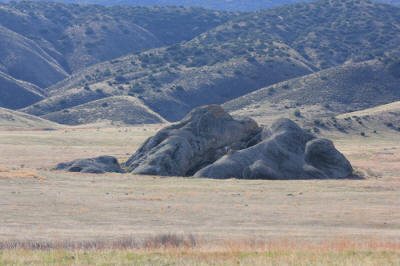Designation Protects More Than 100 Native American Sites
Washington, D.C. — Last week the U.S. Department of the Interior announced the designation of thirteen new National Historic Landmarks in nine different states, including the unique concentration of Native American sites, art, and artifacts of the Carrizo Plain National Monument. The Carrizo’s pictographs, villages and camps (a collection of more than 100 sites) represent some of the first inhabitants of the western United States, dating back thousands of years.
Located in southeastern San Luis Obispo County, adjacent to the Los Padres National Forest, the Carrizo Plain National Monument is known as “California’s Serengeti.” The vast grassland is home to diverse communities of plants and wildlife, including pronghorn antelope, burrowing owls, giant kangaroo rats, San Joaquin kit foxes, and the occasional California condor flying by overhead. Traversed by the San Andreas fault, the plain is a geologic hot spot with Soda Lake, a glistening bed of white salt, set as its centerpiece.
Although today the Carrizo Plain is an arid landscape, up until about 800 years ago the West was much wetter, and water was plentiful on the Carrizo Plain. Native Americans have occupied the area for at least the last 10,000 years. The Monument lies primarily within the historical territory of the Chumash people, though the Salinan (who lived north along the coast to the Salinas Valley) as well as the Yokuts (who lived in the San Joaquin Valley to the east) also visited the Carrizo. The presence these now-protected sites on the Carrizo Plain indicate that this region has long held special value to these tribes. Their descendants continue to revere these places and visit them to conduct ceremonies.
Most famous is the sandstone formation known as Painted Rock, the largest individual pictograph site in the West. About 3,000 to 4,000 years ago, Native Americans began to paint sacred images within the alcove of the rock, including dancing human figures, turtles, rattlesnakes, and geometric shapes. The area is closed to the public except for special Bureau of Land Management tours for a portion of the year to protect the paintings, and available for self-guided tour by permit from mid-July through February.
In order to become a National Historic Landmark, a site must garner a nomination by preservation officials and other interested partners. Completed applications are reviewed by the National Park System Advisory Board, which makes recommendations for designation to the Secretary of the Interior. If selected, property ownership remains the same but each site receives a designation letter, a plaque, and technical preservation advice. The Carrizo Plain National Monument now can boast even more reasons for visitors to enjoy its beauty with the designation of some of its treasures as National Historic Landmarks.








Comments are closed.